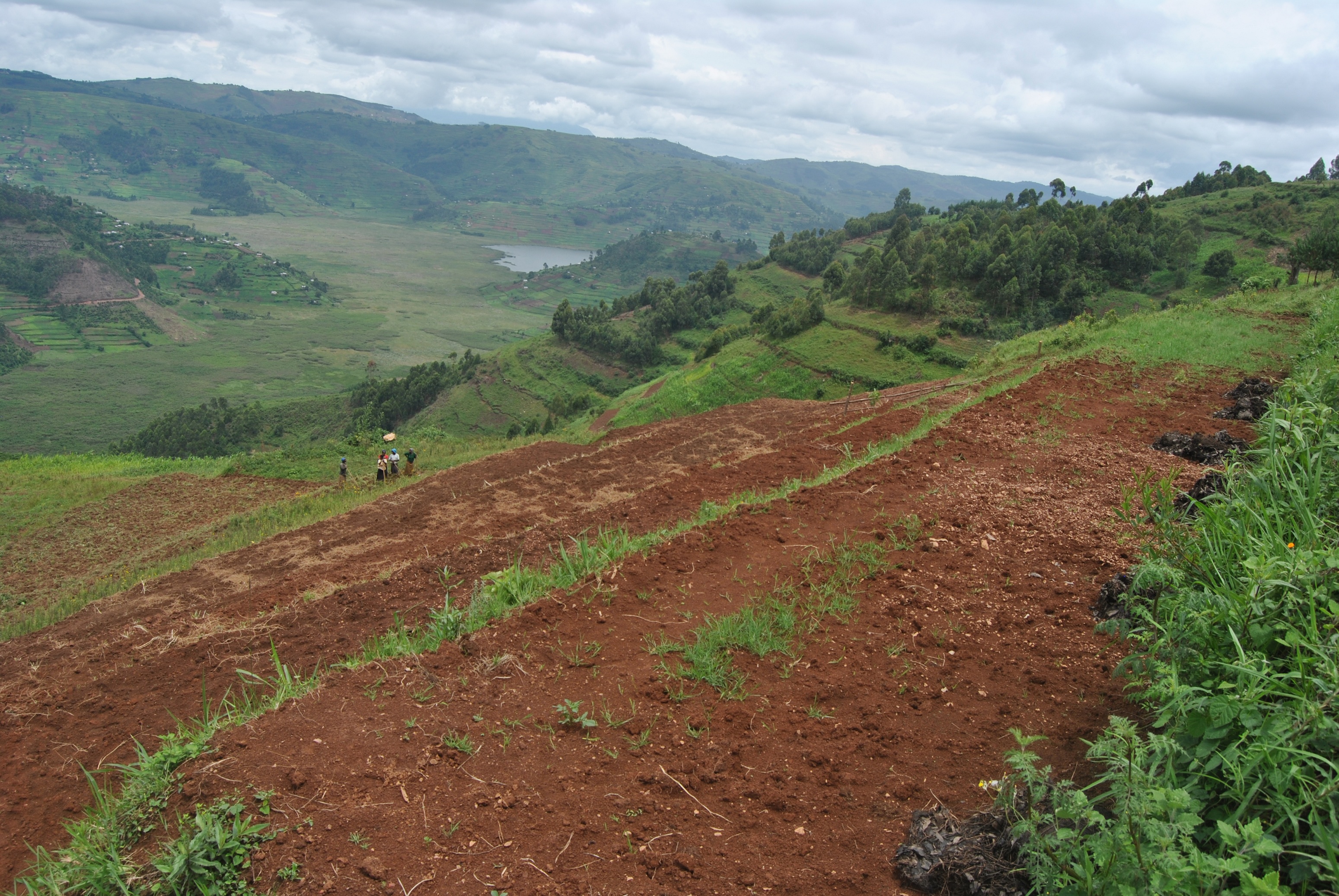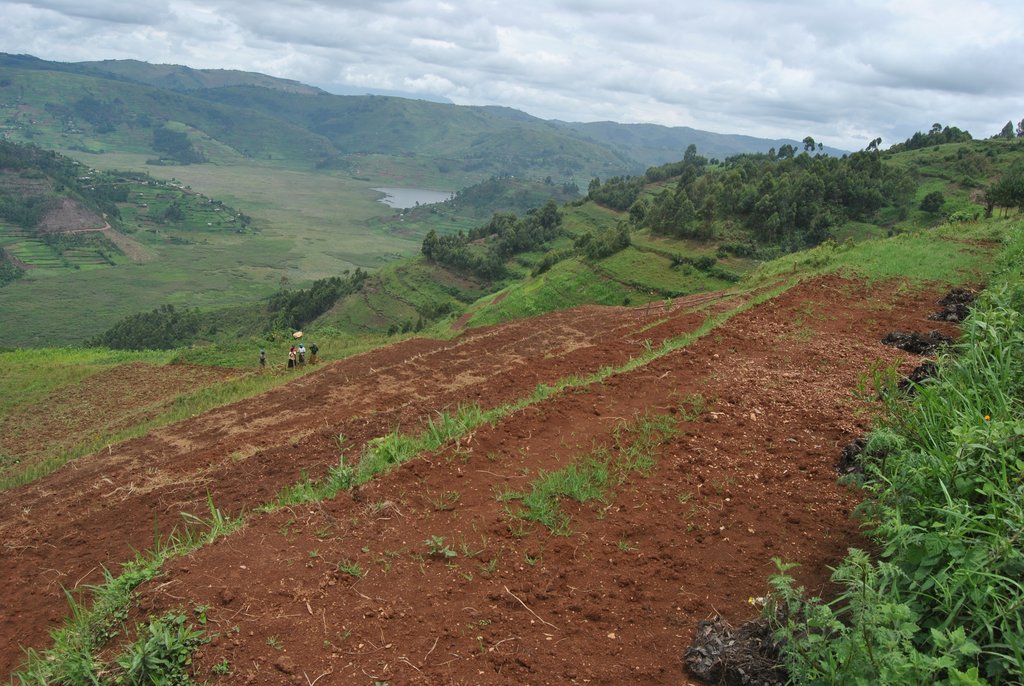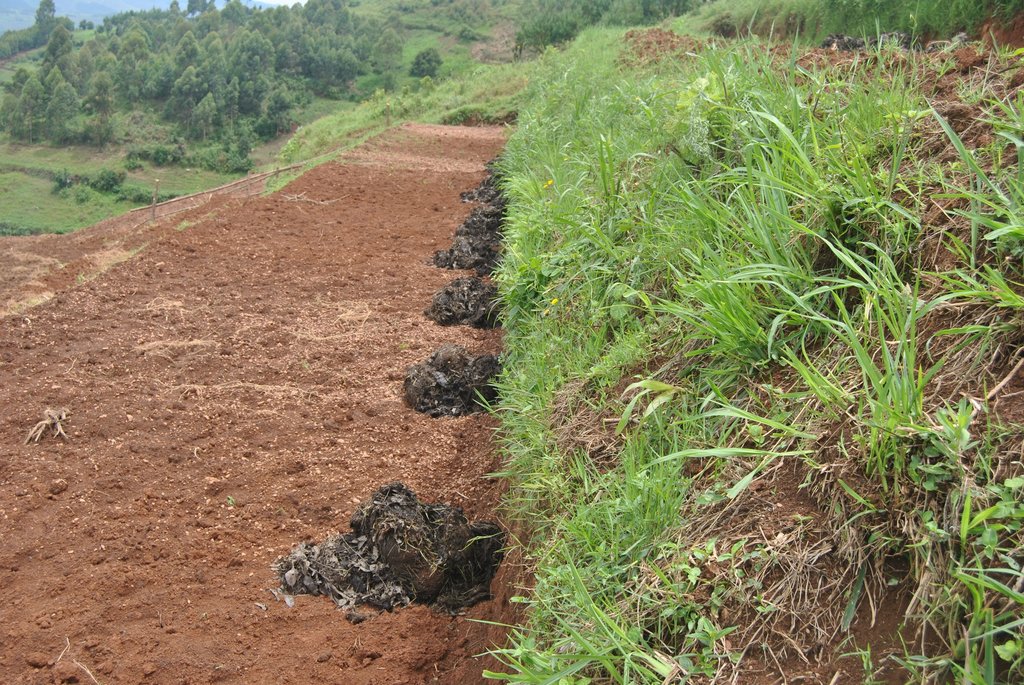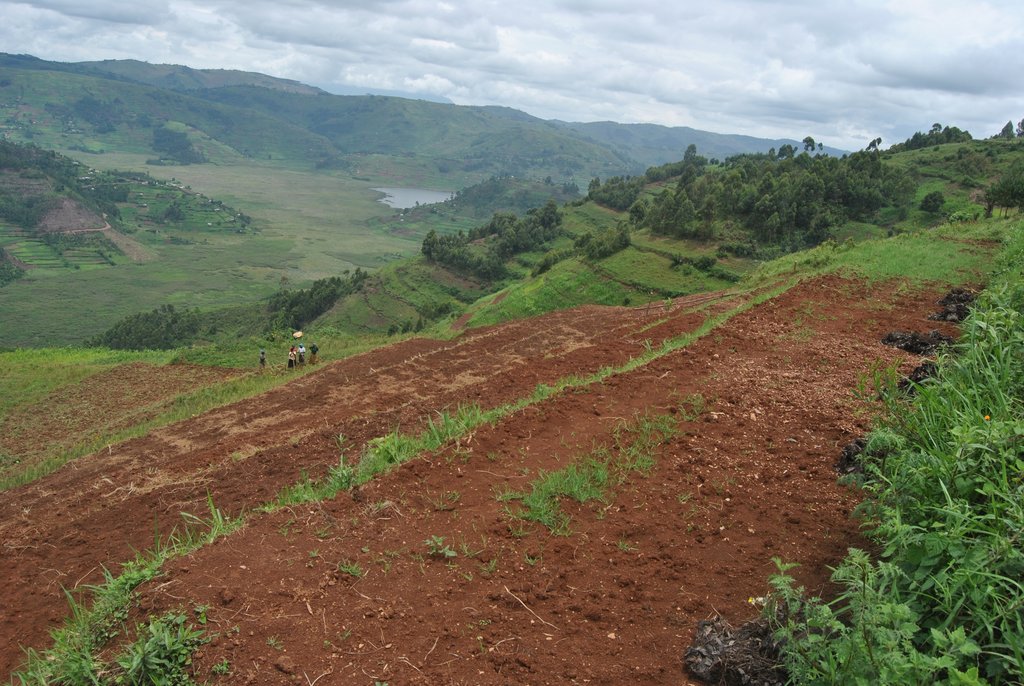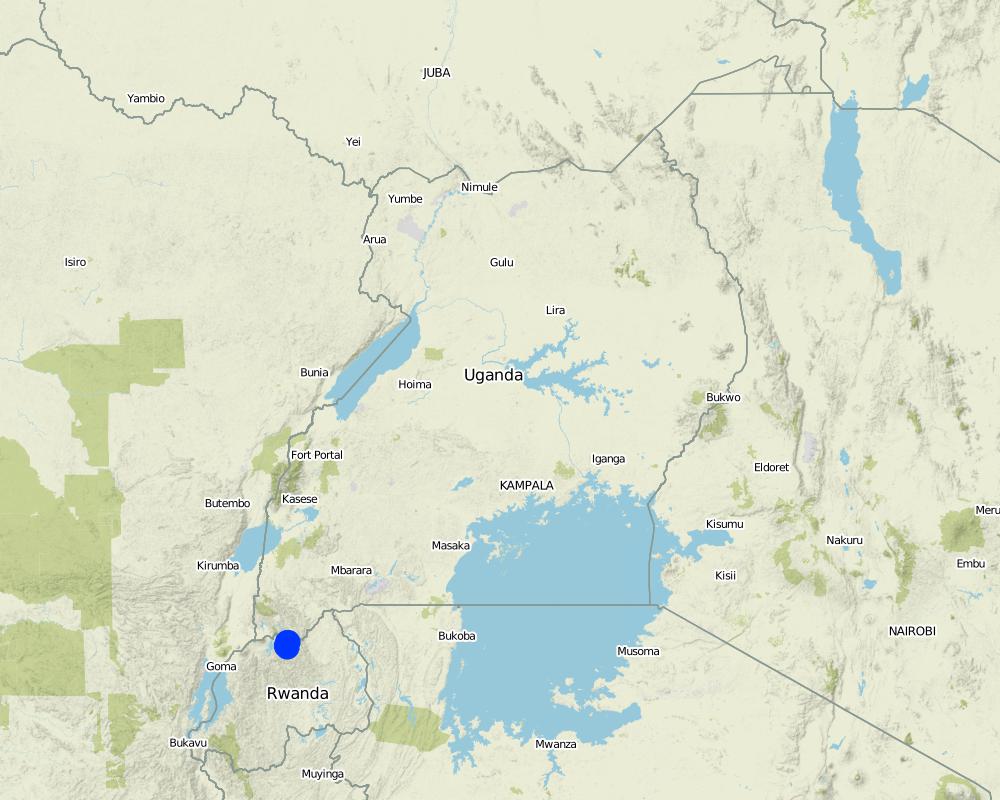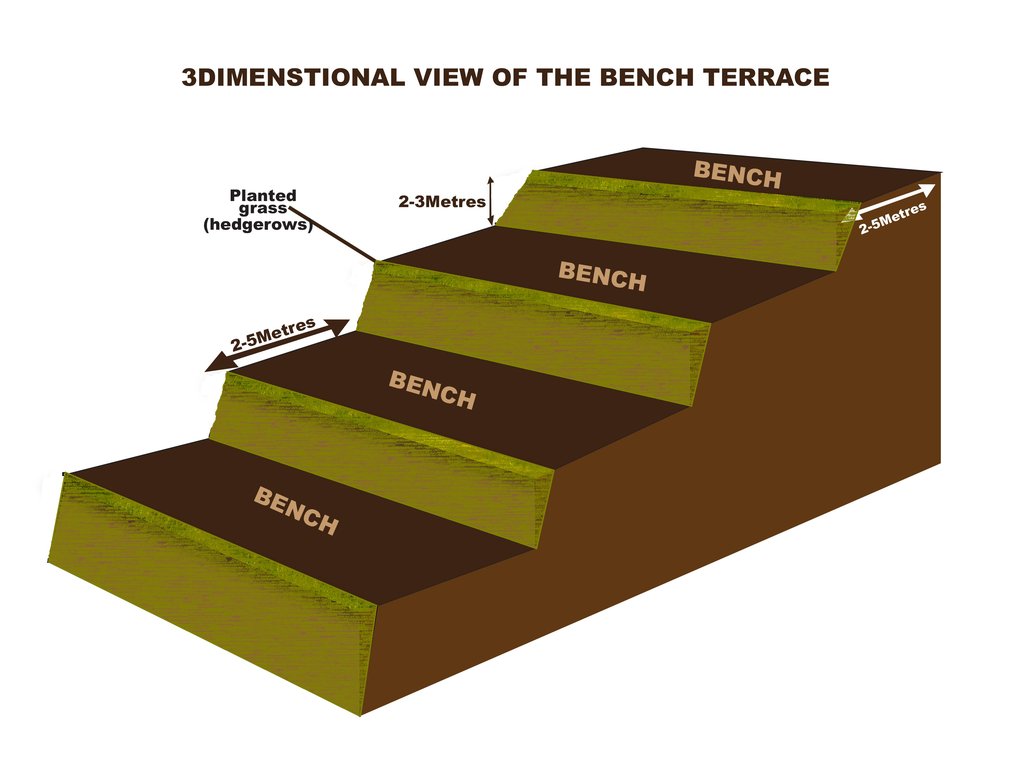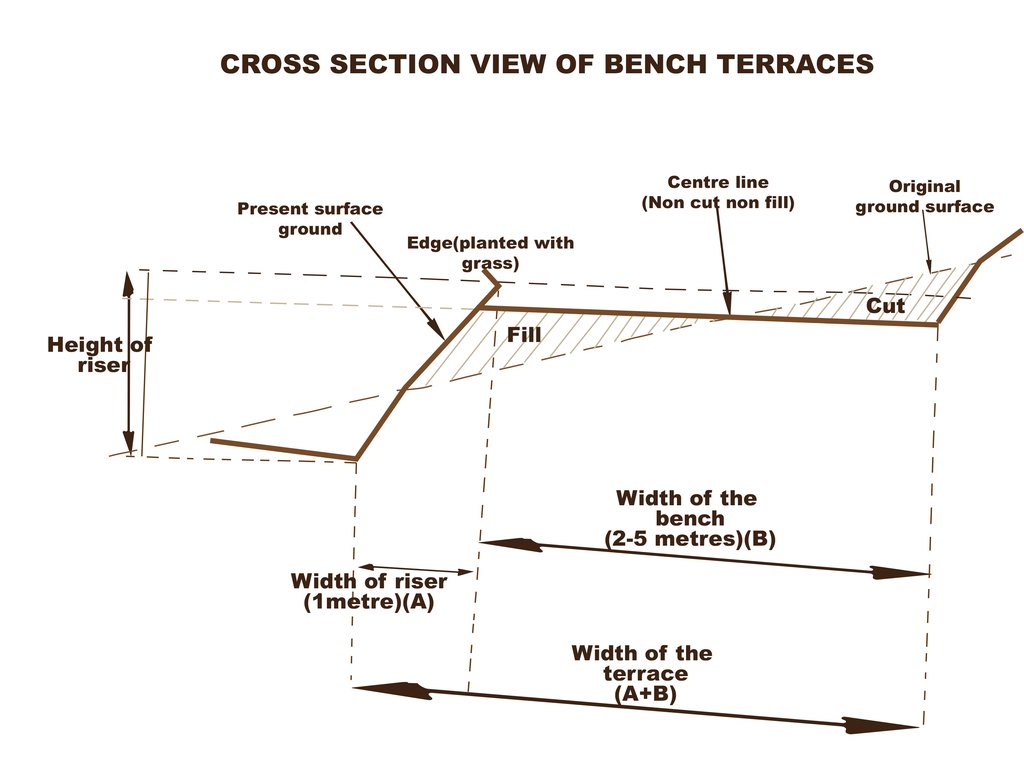Bench Terracing [Uganda]
- Creation:
- Update:
- Compiler: Philip Tibenderana
- Editor: Mirjam Nufer
- Reviewers: Nicole Harari, Hanspeter Liniger, Alexandra Gavilano
Endinganire
technologies_616 - Uganda
View sections
Expand all Collapse all1. General information
1.2 Contact details of resource persons and institutions involved in the assessment and documentation of the Technology
Name of the institution(s) which facilitated the documentation/ evaluation of the Technology (if relevant)
Tear Fund Switzerland (Tear Fund Switzerland) - Switzerland1.3 Conditions regarding the use of data documented through WOCAT
The compiler and key resource person(s) accept the conditions regarding the use of data documented through WOCAT:
Yes
1.4 Declaration on sustainability of the described Technology
Is the Technology described here problematic with regard to land degradation, so that it cannot be declared a sustainable land management technology?
No
Comments:
So far, where this technology has been applied, the water runoff has been reduced and the soils have been stabilised
1.5 Reference to Questionnaire(s) on SLM Approaches (documented using WOCAT)
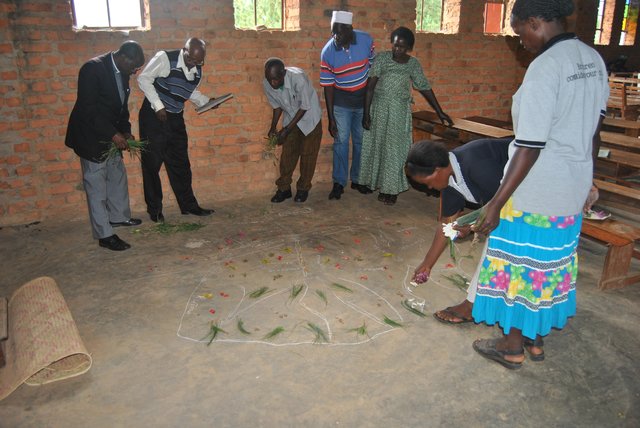
Catchment Based Integrated Water Resources Management [Uganda]
Catchment based integrated water resources management is a process which promotes the coordinated development and management of water, land and related resources in order to maximise economic and social welfare in an equitable manner without compromising the sustainability of vital eco systems
- Compiler: Philip Tibenderana
2. Description of the SLM Technology
2.1 Short description of the Technology
Definition of the Technology:
A bench terrace is an artificial horizontal strip dug across a steep landscape, with a riser ranging between 30 and 45 degrees. Bench terraces are constructed in series and help to minimize land degradation by rainwater runoff
2.2 Detailed description of the Technology
Description:
A typical bench terrace takes the shape of a bench with a width of 3 to 5 meters and the height ranging from 1 to 2 meters, depending on the steepness of the slope, and the length is determined by the size of the plot, but typically 20 to 25 meters.
The top of the terrace riser is planted with a grass strip (referred to as a hedge row) commonly elephant grass or starria grass at a spacing of 200mm. The lower part of the riser is stabilized by planting creeping plant like couch grass to avoid erosion.
The technology is applied in already existing degraded farmlands, which are individually owned. An average farm size is less than half an acre.
This technology reduces the speed of water running down the slope during a downpour thereby reducing soil erosion and increasing water retention.
Areas which are prone to degradation by erosion are identified and later, the farmers are trained on benefits of this technology, how to construct and how to maintain the terraces by planting hegde rows.
This technology helps maintain the good top soil, which would have otherwise been washed down the slope into the valley, increases water retention, provides a flat ground for farm practices. All these ultimately increase crop yields.
What the land users dislike about this technology is that it is labour intensive. These labour intensive activities are done individually, on individual pieces of land using simple hand tools (hoes, spades and pick axes).
2.3 Photos of the Technology
2.5 Country/ region/ locations where the Technology has been applied and which are covered by this assessment
Country:
Uganda
Region/ State/ Province:
South Western Region
Specify the spread of the Technology:
- evenly spread over an area
Comments:
This technology is implemented among farmers in a given area but is adopted by more farmers
Map
×2.6 Date of implementation
Indicate year of implementation:
2015
2.7 Introduction of the Technology
Specify how the Technology was introduced:
- through projects/ external interventions
Comments (type of project, etc.):
The technology was introduced under the Integrated Water Resources Management Project to support farmers to mazimise land productivity
3. Classification of the SLM Technology
3.1 Main purpose(s) of the Technology
- improve production
- reduce, prevent, restore land degradation
- conserve ecosystem
- protect a watershed/ downstream areas – in combination with other Technologies
- reduce risk of disasters
- adapt to climate change/ extremes and its impacts
- mitigate climate change and its impacts
- create beneficial economic impact
- create beneficial social impact
3.2 Current land use type(s) where the Technology is applied
Land use mixed within the same land unit:
Yes
Specify mixed land use (crops/ grazing/ trees):
- Agroforestry

Cropland
- Annual cropping
- Perennial (non-woody) cropping
Annual cropping - Specify crops:
- cereals - barley
- cereals - maize
- cereals - sorghum
- cereals - wheat (spring)
- legumes and pulses - beans
- legumes and pulses - peas
- root/tuber crops - potatoes
- tobacco
- vegetables - leafy vegetables (salads, cabbage, spinach, other)
Number of growing seasons per year:
- 2
Specify:
September to January and March to June

Grazing land

Forest/ woodlands
- Trees, poles, fooder, firewood
3.4 Water supply
Water supply for the land on which the Technology is applied:
- rainfed
3.5 SLM group to which the Technology belongs
- improved ground/ vegetation cover
- integrated soil fertility management
- cross-slope measure
3.6 SLM measures comprising the Technology

vegetative measures
- V1: Tree and shrub cover
- V2: Grasses and perennial herbaceous plants

structural measures
- S1: Terraces
3.7 Main types of land degradation addressed by the Technology

soil erosion by water
- Wt: loss of topsoil/ surface erosion
- Wg: gully erosion/ gullying
- Wm: mass movements/ landslides
3.8 Prevention, reduction, or restoration of land degradation
Specify the goal of the Technology with regard to land degradation:
- reduce land degradation
4. Technical specifications, implementation activities, inputs, and costs
4.1 Technical drawing of the Technology
Technical specifications (related to technical drawing):
Dimensions are shown on the drawings
Author:
Kigezi Diocese Water and Sanitation Programme
Date:
12/12/2016
4.2 General information regarding the calculation of inputs and costs
Specify how costs and inputs were calculated:
- per Technology area
Indicate size and area unit:
Acre
other/ national currency (specify):
Ugandan Shilling
If relevant, indicate exchange rate from USD to local currency (e.g. 1 USD = 79.9 Brazilian Real): 1 USD =:
3300.0
Indicate average wage cost of hired labour per day:
USD 2.1
4.3 Establishment activities
| Activity | Timing (season) | |
|---|---|---|
| 1. | Mark out the plot of land to be terraced | After harvest of crops |
| 2. | Delineation of contours using the A-frame | After harvest of crops |
| 3. | Excavation (cut) and build up bench terrace by filling | After harvest of crops |
| 4. | Stabilising the riser by planting creeping grass and hedge rows | Onset of rains |
4.4 Costs and inputs needed for establishment
| Specify input | Unit | Quantity | Costs per Unit | Total costs per input | % of costs borne by land users | |
|---|---|---|---|---|---|---|
| Labour | Construction of bench terraces in an area of 1 acre | person days | 324.0 | 2.1 | 680.4 | 30.0 |
| Equipment | Forked hoes | pieces | 1.0 | 5.0 | 5.0 | |
| Equipment | Pick axes | pieces | 1.0 | 5.0 | 5.0 | |
| Equipment | Spades | pieces | 1.0 | 5.0 | 5.0 | |
| Plant material | Starria grass cuttings | sack | 80.0 | 7.0 | 560.0 | |
| Total costs for establishment of the Technology | 1255.4 | |||||
| Total costs for establishment of the Technology in USD | 0.38 | |||||
If land user bore less than 100% of costs, indicate who covered the remaining costs:
Kigezi Diocese Water and Sanitation Programme
Comments:
The cost of this technology is beyond the financial capacity of the land user hence the need for a subsidy
4.5 Maintenance/ recurrent activities
| Activity | Timing/ frequency | |
|---|---|---|
| 1. | Repair of damaged parts after heavy downpours | After rainy season |
| 2. | Maintenance of the hedge rows by triming and replanting empty spaces | Continuous |
4.6 Costs and inputs needed for maintenance/ recurrent activities (per year)
| Specify input | Unit | Quantity | Costs per Unit | Total costs per input | % of costs borne by land users | |
|---|---|---|---|---|---|---|
| Labour | Repair of broken parts of the terrace | days | 4.0 | 2.1 | 8.4 | 100.0 |
| Labour | Trimming of hedge rows | days | 8.0 | 2.1 | 16.8 | 100.0 |
| Total costs for maintenance of the Technology | 25.2 | |||||
| Total costs for maintenance of the Technology in USD | 0.01 | |||||
Comments:
The initial investment of the equipment is adequate for maintenance at least for some years
4.7 Most important factors affecting the costs
Describe the most determinate factors affecting the costs:
Establishment costs depend on the steepness of the slope, structure and deepness of the subsoil.
The maintenance costs depend of the degree of damage. Damages vary depending on the severity of rainfall. Soils that are more sandy are more likely to be swept than those that are clayey. The location of the terrace (whether up hill or down hill) will determine how badly the terrace will be damaged and hence the costs of repair. The steepness of the slope will also affect the extent to which the terraces are damaged
5. Natural and human environment
5.1 Climate
Annual rainfall
- < 250 mm
- 251-500 mm
- 501-750 mm
- 751-1,000 mm
- 1,001-1,500 mm
- 1,501-2,000 mm
- 2,001-3,000 mm
- 3,001-4,000 mm
- > 4,000 mm
Specifications/ comments on rainfall:
Bi-modal rainfall pattern with long rainy season from Spetember to December then March to May
Indicate the name of the reference meteorological station considered:
Kabale District Meterological Department
Agro-climatic zone
- sub-humid
5.2 Topography
Slopes on average:
- flat (0-2%)
- gentle (3-5%)
- moderate (6-10%)
- rolling (11-15%)
- hilly (16-30%)
- steep (31-60%)
- very steep (>60%)
Landforms:
- plateau/plains
- ridges
- mountain slopes
- hill slopes
- footslopes
- valley floors
Altitudinal zone:
- 0-100 m a.s.l.
- 101-500 m a.s.l.
- 501-1,000 m a.s.l.
- 1,001-1,500 m a.s.l.
- 1,501-2,000 m a.s.l.
- 2,001-2,500 m a.s.l.
- 2,501-3,000 m a.s.l.
- 3,001-4,000 m a.s.l.
- > 4,000 m a.s.l.
Indicate if the Technology is specifically applied in:
- not relevant
5.3 Soils
Soil depth on average:
- very shallow (0-20 cm)
- shallow (21-50 cm)
- moderately deep (51-80 cm)
- deep (81-120 cm)
- very deep (> 120 cm)
Soil texture (topsoil):
- medium (loamy, silty)
Soil texture (> 20 cm below surface):
- medium (loamy, silty)
Topsoil organic matter:
- medium (1-3%)
5.4 Water availability and quality
Ground water table:
> 50 m
Availability of surface water:
good
Water quality (untreated):
poor drinking water (treatment required)
Is water salinity a problem?
No
Is flooding of the area occurring?
Yes
Regularity:
episodically
Comments and further specifications on water quality and quantity:
Water quantity and quality is dependent on human activities and rainfall patterns
5.5 Biodiversity
Species diversity:
- medium
Habitat diversity:
- medium
5.6 Characteristics of land users applying the Technology
Sedentary or nomadic:
- Sedentary
Market orientation of production system:
- subsistence (self-supply)
- mixed (subsistence/ commercial)
Off-farm income:
- less than 10% of all income
Relative level of wealth:
- poor
Individuals or groups:
- individual/ household
Level of mechanization:
- manual work
Gender:
- women
Age of land users:
- youth
- middle-aged
5.7 Average area of land used by land users applying the Technology
- < 0.5 ha
- 0.5-1 ha
- 1-2 ha
- 2-5 ha
- 5-15 ha
- 15-50 ha
- 50-100 ha
- 100-500 ha
- 500-1,000 ha
- 1,000-10,000 ha
- > 10,000 ha
Is this considered small-, medium- or large-scale (referring to local context)?
- small-scale
5.8 Land ownership, land use rights, and water use rights
Land ownership:
- individual, not titled
Land use rights:
- individual
Water use rights:
- communal (organized)
5.9 Access to services and infrastructure
health:
- poor
- moderate
- good
education:
- poor
- moderate
- good
technical assistance:
- poor
- moderate
- good
employment (e.g. off-farm):
- poor
- moderate
- good
markets:
- poor
- moderate
- good
energy:
- poor
- moderate
- good
roads and transport:
- poor
- moderate
- good
drinking water and sanitation:
- poor
- moderate
- good
financial services:
- poor
- moderate
- good
6. Impacts and concluding statements
6.1 On-site impacts the Technology has shown
Socio-economic impacts
Production
crop production
Comments/ specify:
The impact has come immediately with the first crop
crop quality
fodder production
Comments/ specify:
Hedge rows are used as fodder
fodder quality
risk of production failure
product diversity
Comments/ specify:
With terracing more variety of crops are being grown
production area
land management
Income and costs
expenses on agricultural inputs
farm income
diversity of income sources
workload
Socio-cultural impacts
food security/ self-sufficiency
Comments/ specify:
It is expected to improve in the long term
health situation
community institutions
SLM/ land degradation knowledge
conflict mitigation
Ecological impacts
Water cycle/ runoff
surface runoff
groundwater table/ aquifer
Comments/ specify:
Recharge is hoped to increase in the long term as more farmers adopt the technology
Soil
soil moisture
soil cover
soil loss
soil accumulation
Comments/ specify:
Soil which is trapped by the hedge rows
soil organic matter/ below ground C
Comments/ specify:
By use of manure
Climate and disaster risk reduction
flood impacts
Comments/ specify:
Flooding in the valley bottoms due to runoff
6.2 Off-site impacts the Technology has shown
water availability
Comments/ specify:
As more people adopt the technology, this is expected to increase
downstream flooding
Comments/ specify:
Trend in downstream flooding is negative
downstream siltation
Comments/ specify:
Trend in downstream siltation is negative
damage on neighbours' fields
Comments/ specify:
Soil which is washed down the slope
damage on public/ private infrastructure
Comments/ specify:
Especially on roads and water supply systems
6.3 Exposure and sensitivity of the Technology to gradual climate change and climate-related extremes/ disasters (as perceived by land users)
Gradual climate change
Gradual climate change
| Season | increase or decrease | How does the Technology cope with it? | |
|---|---|---|---|
| annual temperature | increase | not known | |
| seasonal temperature | dry season | increase | not known |
| seasonal temperature | wet/ rainy season | increase | not known |
| annual rainfall | decrease | not known | |
| seasonal rainfall | wet/ rainy season | decrease | not known |
Climate-related extremes (disasters)
Meteorological disasters
| How does the Technology cope with it? | |
|---|---|
| local rainstorm | well |
| local thunderstorm | well |
| local hailstorm | well |
Climatological disasters
| How does the Technology cope with it? | |
|---|---|
| land fire | well |
Hydrological disasters
| How does the Technology cope with it? | |
|---|---|
| general (river) flood | very well |
| flash flood | very well |
| landslide | very well |
Biological disasters
| How does the Technology cope with it? | |
|---|---|
| epidemic diseases | moderately |
| insect/ worm infestation | not known |
6.4 Cost-benefit analysis
How do the benefits compare with the establishment costs (from land users’ perspective)?
Short-term returns:
positive
Long-term returns:
positive
How do the benefits compare with the maintenance/ recurrent costs (from land users' perspective)?
Short-term returns:
positive
Long-term returns:
very positive
Comments:
The adoption rate of this technology is gradual as people keep appreciating the benefits
6.5 Adoption of the Technology
- single cases/ experimental
If available, quantify (no. of households and/ or area covered):
24 households (15 households were experimental and 9 have adopted)
Of all those who have adopted the Technology, how many did so spontaneously, i.e. without receiving any material incentives/ payments?
- 91-100%
6.6 Adaptation
Has the Technology been modified recently to adapt to changing conditions?
No
6.7 Strengths/ advantages/ opportunities of the Technology
| Strengths/ advantages/ opportunities in the land user’s view |
|---|
| Reduction of erosion damage by capturing or slowing down surface runoff |
| Trap and retain sediments from the slope above and accelerates re-vegetation process on the bare slopes |
| Creates a flat leveled ground for easier cultivation |
| The planted hedgerows provide fodder for the animals |
| Strengths/ advantages/ opportunities in the compiler’s or other key resource person’s view |
|---|
| Increases soil moisture since the trapped water is retained as surface runoff is minimized |
6.8 Weaknesses/ disadvantages/ risks of the Technology and ways of overcoming them
| Weaknesses/ disadvantages/ risks in the land user’s view | How can they be overcome? |
|---|---|
| Bench terraces cannot be constructed on slopes with sandy or rocky soils because they can collapse | N/A |
| Weaknesses/ disadvantages/ risks in the compiler’s or other key resource person’s view | How can they be overcome? |
|---|---|
| Bench terraces may cause sloughing if too much water infiltrates the soil | Suitable runoff outlets are created to carry away the excess runoff |
7. References and links
7.1 Methods/ sources of information
- field visits, field surveys
Observation field visits to the constructed bench terraces
- interviews with land users
Focus group discussion with 18 land users (5 females and 13 males)
- interviews with SLM specialists/ experts
Project implement staff
- compilation from reports and other existing documentation
Integrated Water Resources Management project reports
When were the data compiled (in the field)?
07/09/2016
7.2 References to available publications
Title, author, year, ISBN:
Kigezi Diocese Water and Sanitation Programme, IWRM Annual Report (April 2015 - March 2016)
Available from where? Costs?
www.kigezi-watsan.ug
Title, author, year, ISBN:
Empowering communities through Water SMART agricultural practices
Available from where? Costs?
www.kigezi-watsan.ug
Title, author, year, ISBN:
IWRM Pilot Report
Available from where? Costs?
www.kigezi-watsan.ug
7.3 Links to relevant online information
Title/ description:
Bench terraces
URL:
www.fao.org/docrep/006/ad083e/ad083e07.htm
Links and modules
Expand all Collapse allLinks

Catchment Based Integrated Water Resources Management [Uganda]
Catchment based integrated water resources management is a process which promotes the coordinated development and management of water, land and related resources in order to maximise economic and social welfare in an equitable manner without compromising the sustainability of vital eco systems
- Compiler: Philip Tibenderana
Modules
No modules


